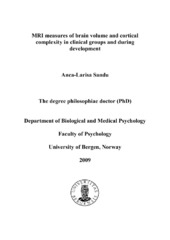MRI measures of brain volume and cortical complexity in clinical groups and during development
Doctoral thesis
Permanent lenke
https://hdl.handle.net/1956/3604Utgivelsesdato
2009-05-07Metadata
Vis full innførselSamlinger
Sammendrag
The complex structure of the surface of the brain might elude classical magnetic resonance imaging (MRI) methods of characterization, when it comes to measures of surface irregularities. Such measures may be important when studying brain structural abnormalities in various clinical groups. By combining volumetric measures of grey (GM) and white matter (WM) with the characterization of the complexity of the border between them by the calculation of fractal dimension (FD), new information can be retrieved about structural modifications in development, clinical impairments and diseases. These measures were used in the present thesis when studying brain development and differences between males and females, and when comparing brain structural abnormalities in clinical groups. The first study in the current thesis was done on patients with schizophrenia, comparing our results with previous findings and testing the reliability of the fractal dimension measurement by use of validation procedures. The results confirmed previous research and found significantly larger abnormalities in the schizophrenia patients compared to healthy control subjects, in the complexity of the cortical foldings. The second study was focused on dyslexia, comparing boys and girls. MRI structural differences were found in GM and WM volume, the GM/WM ratio and the FD measurement, revealing differences between the groups in complexity of the border between GM and WM. Of particular importance was the finding that changes were more marked for the dyslexia girls, indicating more serious effects in girls once they show signs of dyslexia. Structural changes also occur during maturation and development, as found in the third study, which compared adolescents with young adults. Structural brain differences were more pronounced in the right hemisphere, and in the young females. It is concluded that the results of the present thesis show the importance of using volumetric measures together with shape characterization techniques, like the fractal dimension, when studying brain structural development and maturation and in clinical groups.
Består av
Paper I: Computerized Medical Imaging and Graphics 32(2), Sandu, A.-L.; Rasmussen jr., I.-A.; Lundervold, A.; Kreuder, F.; Neckelmann, G.; Hugdahl, K.; Specht, K., Fractal dimension analysis of MR images reveals grey matter structure irregularities in schizophrenia, pp. 150–158. Copyright 2007 Elsevier Ltd. Full text not available in BORA due to publisher restrictions. The published version is available at: http://dx.doi.org/10.1016/j.compmedimag.2007.10.005Paper II: Neuroscience Letters 438(1), Sandu, A.-L.; Specht, K.; Beneventi, H.; Lundervold, A.; Hugdahl, K., Sex-differences in grey-white matter structure in normal-reading and dyslexic adolescents, pp. 80-84. Copyright 2008 Elsevier Ireland Ltd. Full text not available in BORA due to publisher restrictions. The published version is available at: http://dx.doi.org/10.1016/j.neulet.2008.04.022
Paper III: Sandu, A.-L.; Specht, K.; Beneventi, H.; Hugdahl, K., 2009, Post-adolescent developmental changes in grey-white matter brain structure: Effects of gender. Full text not available in BORA.
